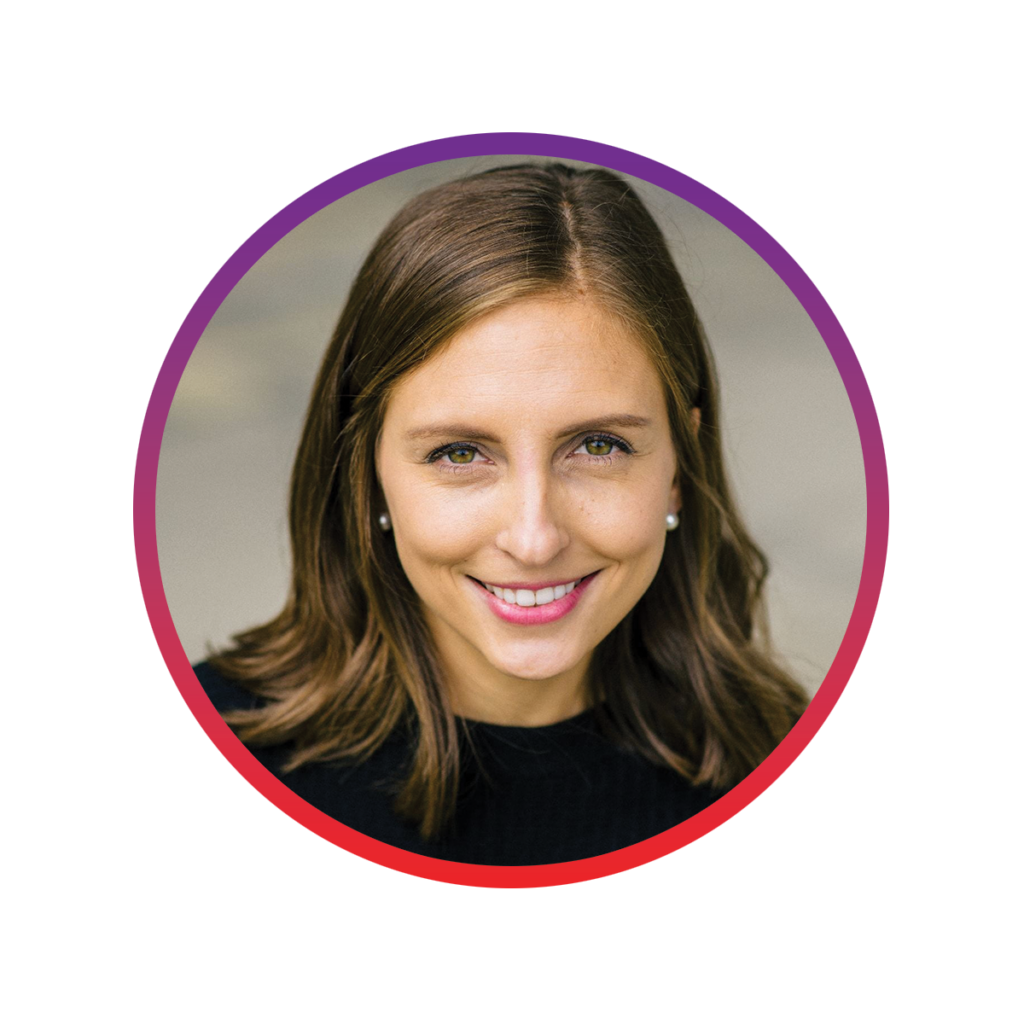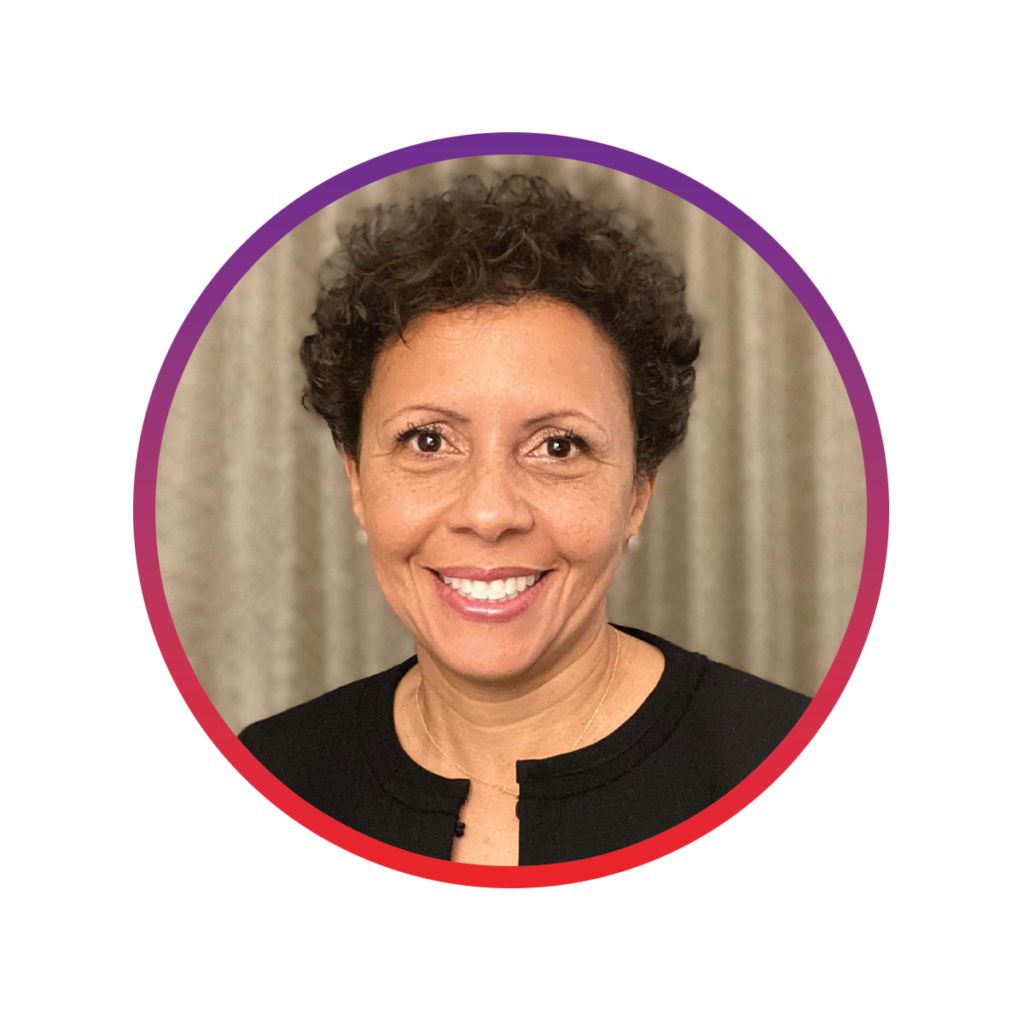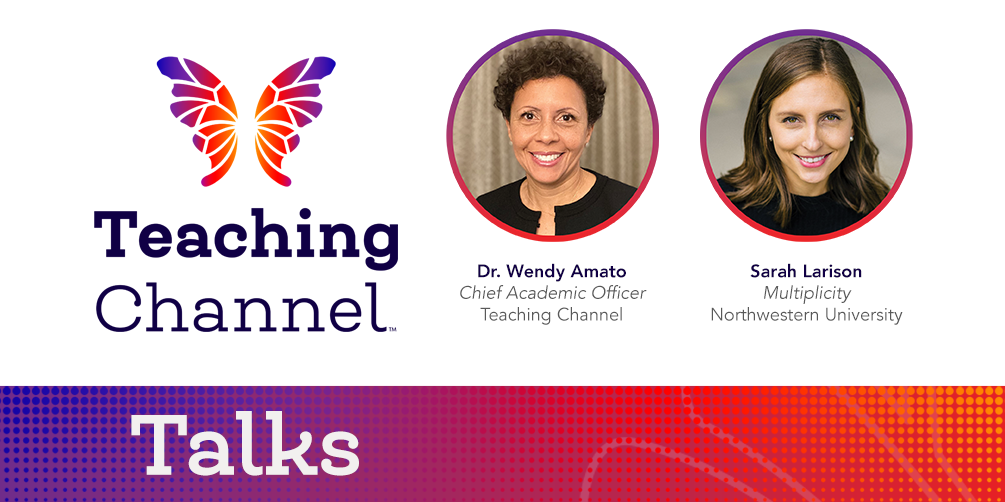How can a single image spark rich mathematical discussions?
In this episode of Teaching Channel Talks, Dr. Wendy Amato welcomes Sarah Larison from Northwestern to explore Multiplicity(Open Link in new tab), a platform designed to transform math instruction through rich images and meaningful discussions. Sarah shares how this innovative approach, born during the pandemic, continues to engage students and empower teachers by making math more accessible and collaborative. Learn how Multiplicity fosters deep mathematical thinking, supports multilingual learners, and builds teacher confidence—one image at a time.
Our Guest

Sarah Larison is currently a doctoral student in learning sciences at Northwestern University. A former elementary school teacher working in Chicago public schools, Sarah is passionate about rehumanizing mathematics teaching and learning in schools and supporting teacher learning and development.
Connect with Sarah and Multiplicity on Instagram(Open Link in new tab).
Our Host

Dr. Wendy Amato is the Chief Academic Officer at Teaching Channel’s parent company, K12 Coalition(Open Link in new tab). Wendy earned her Master’s in Education and Ph.D. in Curriculum and Instruction from the University of Virginia. She holds an MBA from James Madison University. Wendy began teaching in 1991, has served as a Middle School Administrator, and still teaches at UVA’s School of Education. She has delivered teacher professional development workshops and student leadership workshops in the US and internationally. Wendy and her family live near Charlottesville, Virginia.
Resources for Continued Learning
Explore the tools and resources mentioned in the episode to enhance math instruction in your classroom:
Get Started with Multiplicity. (Open Link in new tab) Engage students in meaningful mathematical discussions using carefully curated images and inquiry-based tasks. Multiplicity provides a low-floor, high-ceiling approach that encourages flexible thinking and collaborative problem-solving. Try discussing Multiplicity at your next PLC meeting and collaborate with colleagues to curate images that align with key math concepts in your curriculum!
- New to the platform? Follow this step-by-step guide(Open Link in new tab) to select tasks, facilitate discussions, and integrate Multiplicity into your instruction with confidence.
Advance Your Math Instruction with Teaching Channel: Looking to boost your teaching skills and advance your salary? Teaching Channel’s 3-credit math courses are designed to help educators grow professionally while making a greater impact in their classrooms.
Episode Transcript
Dr. Wendy Amato 00:00
Welcome to Teaching Channel Talks. I’m your host, Wendy Amato, and as often as I can, I jump into conversations about topics that matter in education. In this episode, Sarah Larrison from Northwestern is going to open up for us the world of math. Sarah, welcome. Thanks, Wendy. You’ve been involved in multiplicity.
What is it?
Sarah Larison 00:22
Yeah, so multiplicity. My colleague Jen had this idea during the pandemic that kids needed good math instruction more than ever. So she saw a real opportunity to create a platform and create tasks where teachers could share a rich image with students and ask them some purposeful questions to get them talking about math.
It’s a really simple premise, and it proved to be really powerful. It was a way to make teaching remotely manageable for teachers and to get students really rich discourse around math and to be thinking about math in expanded ways. And since then it’s kind of taken off, people still wanted us to keep going with it.
So it’s developed in other ways as well.
Dr. Wendy Amato 01:05
I’ve heard a lot in mathematics about using manipulatives. Can you talk to me about the, this role of images is that in place of or why is that a special element?
Sarah Larison 01:17
That’s a great question. I mean, it really started with the constraints of the pandemic and being on zoom.
So it was a way to look at something that was interesting and worth talking about where you didn’t need to have manipulatives necessarily. But definitely not in place of now that teachers have moved back into their classrooms, we actually encourage them to offer students manipulatives to make sense of the images or to even extend what the images are.
Like a lot of these are photos of manipulatives. That’s exactly what they are. So giving students manipulatives to create their own rich images to talk about as well.
Dr. Wendy Amato 01:55
I like thinking that a teacher can project an image and create really a shared experience for the class and talk about the arrangement or the representation in a whole class way and then support that with the individual work.
It’s smart. Sarah, since the demand for the use of images emerged during the pandemic, how do you explain the continued demand since then?
Sarah Larison 02:23
I think during the pandemic, it was really obvious that teaching and learning was constrained over Zoom. So that’s where the idea of just simply showing an image and asking good questions came from.
It was also because in some ways there was a constraint. I think teachers were able to really internalize the importance of having mathematical discussions. That’s something we’ve known from the research for years. That’s really important, but still doesn’t happen as much as it could in classrooms. So I think because of the pandemic and because that’s all there was to do was talk in some ways it gave teachers perhaps more of A way into that sort of instruction where students are making sense together.
It’s really, truly a collective, collaborative mathematical process.
Dr. Wendy Amato 03:11
It sounds like they got a taste of something great and then just had to keep it coming. You’ve talked to me about. The way teachers need help teaching. You’ve talked to me about how students need strong instruction and they hear multiplicity arriving at the intersection of those two things.
Can you give me an example of something that somebody would find and be able to use in the multiplicity world?
Sarah Larison 03:37
Definitely. So I’m a former elementary school teacher. I taught kindergarten through third grade and it’s hard being a teacher. You have like over 30 students who all need something different and it’s nearly impossible.
It can feel nearly impossible to get students what they need all the time. I think that The tasks we offer and the structures for them are a way to offer a rich space for students to make sense wherever they may be. A lot of people call this a low floor, high ceiling tasks. So for instance, if I showed you an image of a bunch of dice, which maybe this is where we can show it on the screen.
And you ask students how many, there are a variety of ways students can respond to that task. And that is sort of the point of this whole thing. We know, for instance, like benchmarks like counting by fives and tens are really important for students developing efficiency and fluency with mathematics and students can look at an image like this and know right away that two fives is a 10 and they can count by tens.
They can count. Each row by itself. They might even be counting each individual dot on the die if they haven’t learned to subitize that five yet. And so there are a bunch of different ways that students can make sense and extend their own thinking in a way that creates a really rich environment to think too, and to also recognize that we have different ways of thinking about the math and all of those ways are very valid.
Dr. Wendy Amato 05:06
In selecting images, what are the key criteria that you would want a teacher to consider?
Sarah Larison 05:13
So we have organized our tasks by the image type. So if your students are really into, say, dominoes or playing cards, something like that gets them really motivated and invested. You can Search for images by the type of manipulative, or if you’re looking at real world images, for instance, you can also search by different mathematical big ideas like I just mentioned, making fives and making tens.
Alternatively, you can search by big questions so as much as I say there’s like a lot of different entry points for students, I think they’re equally many entry points for teachers, depending on what the goals that they have are.
Dr. Wendy Amato 05:52
I’m happy to hear a range of entry points for teachers because the work that you do is characterized by its manageableness.
And that’s probably part of why there’s a growing awareness of the work that you’ve been doing for a while. Talk to me about how you have grown a teacher advisory board. That’s a really interesting element of the work you’re doing.
Sarah Larison 06:14
Yeah, definitely. Like I said, teachers got really interested in this work pretty quickly, and they wanted more.
And right now it’s mostly just Jen and I working together on this, trying to figure out, you know, how can we expand this in ways that make sense to teachers. So, we decided to Why don’t we ask teachers and put the sort of agency and authority in their own hands to tell us what they need, what’s happening in their classrooms.
So for instance, one thing is teachers were really interested in creating tasks in different languages so they could reach their multilingual learners. So that’s an ongoing project. We’re working on getting all of our tasks translated into Spanish and Portuguese. We also invite teachers to bring images to us that represent their local context to make it relevant and culturally rich for their students say things around them that they’re engaging with and they’re interested in and then sharing those more broadly with our audience allows them to see different cultural perspectives as well and connect those to the mathematics.
Dr. Wendy Amato 07:17
I love thinking about using the images to expose students to the things that are really around them on a daily basis. We might accidentally trip over mathematical thinking in our regular daily lives. Exactly. So are you saying that teachers can send images to you to add to this bank?
Sarah Larison 07:36
You know what? We asked the teacher advisory board to do that, but we’d be more than happy if other teachers had different ideas they wanted to share as well.
Absolutely. I think the more teacher voices that we have, the better.
Dr. Wendy Amato 07:48
That always sounds smart. There are so many schools and districts emphasizing collaboration and shared resources and interdisciplinary work, the more voices, the more perspectives, the more examples starts to just make sense. The multiplicity lab describes itself as doing math involves multiple ideas, voices, strategies, ways of seeing, ways of thinking, ways of being.
Does that represent some core value that you have?
Sarah Larison 08:17
That’s a great question. I think there’s this persistent myth in mathematics. That there’s sort of one right way to do math or there’s always one particular answer. But we know a lot of the richest mass math thinking occurs at the intersection of real life context and authentic questions that don’t necessarily have the right answer.
One answer. So something that we really tried to make visible and all of our tasks is that you cannot only approach it in a multiple different ways, but you can come up with multiple different ideas about how to answer the questions that are all equally valid, just depending on the logic that you’re drawing from.
And I think one of one thing that’s really important to us is the fact that these are meant to be shared. These are answers. Activity is not for students to think about on their own and leave it at that, but to talk about in discourse. And when we get all of these multiple ideas out among a group, it creates the conditions for really, really rich math thinking and learning.
Dr. Wendy Amato 09:23
I’m going to make trouble right now. Are you telling me that we’re saying to math teachers, it’s okay to have a whole bunch of different answers? It’s okay if everyone sort of arrives at a different conclusion. What about the diehards who say this is the order of operation or this answer is wrong?
Sarah Larison 09:44
I think the key is less about what the answer is or what can be counted as an answer. And more. The question is, what were students thinking? How are they making sense to get to this? A lot of times with these tasks for younger kids in particular, they might be looking at a different unit when you say how many they might be counting the dots on the die, or they might be counting the die themselves.
And that is a really consequential difference. So it’s not to say that, you know, there could be 10 different answers, and that’s the thing we should focus on, but rather What are the logics that underlie the things that students say? And what can we learn from those logics that we can bring into conversation?
For instance, in that case, we can generalize, Hey, when you ask how many, the idea of units really matters. And that gets students thinking and extending their thinking to consider different units when maybe they hadn’t thought of that before.
Dr. Wendy Amato 10:38
That’s a great answer. The question was fine, but the answer was really good.
This all boils down to clarity. What are we talking about and do we share the understanding of what we’re talking about? This is great.
Sarah Larison 10:54
I think so. I think something else that really resonates, if I may kind of like add a little plug for something, is I think many elementary school teachers feel uncomfortable with the math.
And when they’re teaching math, I think that our activities are a way to open different mathematical ideas, not just to students, but to teachers as well, so they can co construct an idea about what does it mean when we ask about how many are there, like estimating is really sophisticated mathematical work, for instance, and it helps us start breaking down the sort of the mechanics of these big mathematical practices and ideas for both students and teachers.
Dr. Wendy Amato 11:31
It is true math and science tend to get the fewest instructional minutes at the elementary and particularly the lower elementary levels, and I wonder if it is about teacher confidence or access to materials that, that are comfortable.
Sarah Larison 11:49
I think so. And I think it’s beyond teachers. I think it’s people and parents too.
I know that when I post something on our multiplicity Instagram, my friends and family are like, did I do it right? Is this the answer? And I laugh every time because it’s like, that is so not the point, but it’s so hard to hear those cultural myths and ideas. that make people really itchy about the math.
So we’re also, I think, just as much trying to share the idea that math can be enjoyable, it can be fun, it can be game like, and it can be shared.
Dr. Wendy Amato 12:21
When I have explored the website, I’ve noticed my favorite page is the page of videos where I can see specific activities being modeled. Is there one there that you could tell me more about?
Sarah Larison 12:33
So something about these videos that I think is really important is that We’ve created tasks with accompanying. Rich questions to ask students. Something else we know is really important for teachers is to be able to anticipate what students will say. That way they’re primed to hear what students are thinking and how they can respond to them in ways to extend their thinking.
So really a big point of these videos is to open up our minds collectively to consider what students could say. We’re not trying to list everything they will say. We could never do that, but to give teachers an idea of the types of possibilities, and then get them thinking about in turn how they might further probe students to continue to extend their thinking.
Dr. Wendy Amato 13:19
There’s some reassurance there. If you expect a range of answers, then you can be more welcoming of a range of answers.
Sarah Larison 13:28
I think that’s true. I do. And I also I just want to also say that it’s okay to pause. Students will always say something that we weren’t expecting. And I think as teachers, sometimes we feel like we need to evaluate it or to respond immediately in the next second.
But it’s okay to say I don’t understand what you mean, can you tell me more? And I think these tasks offer a space for teachers and students to create that kind of culture of mathematical thinking, of slow mathematical thinking and reasoning.
Dr. Wendy Amato 13:58
Every teacher’s had a humdinger of a moment where a student contribution just leaves you stumped.
When you recorded the activities videos it looks like you were very careful to keep one concept at a time there. How did you prioritize those?
Sarah Larison 14:15
That’s a good question. So we have seven big questions that we create tasks with it. And all of them are meant to hit different big mathematical ideas, but they kind of all lend themselves to different images.
So for instance, when we say about how many do you see, Again, I’m going to plug for estimating. Nobody talks about estimating enough. It’s so sophisticated, and it’s something that we do in real life all the time we have to do. One piece of estimating is finding benchmarks to compare within an image, for instance.
So by focusing on just that question in this video, for instance, we can show teachers sort of the mechanics that go into estimating so they can be primed to think about how students Are you using benchmarks or could be nudged in the direction to find benchmarks to use to begin estimating?
Dr. Wendy Amato 15:06
I’ve mentioned the activities that are on the website and I’m wondering if you can take us on a little bit of a tour.
Maybe some suggestions for how to navigate what you have carefully provided for educators everywhere. I started to say for math educators everywhere, but really this is a way of thinking and approaching learning for students and so I won’t narrow to math teachers.
Sarah Larison 15:28
I love it. Wendy, I could not agree with you more.
When you get on our website, I think there’s a few different directions you could go. We have a tab called Getting Started. There’s a guide that sort of walks you through step by step what you might want to do to choose the first task that you show your students and how to facilitate the discussion and reflect on it.
Like you mentioned, we also have videos to sort of illustrate the type of things that you might expect from a lesson like this. Or if you feel ready to jump right in and try it out, you can go to our tab with our two different types of routines. They’re called look, think, talk, and off you go. And you can search again by different criteria, like the material in the image, the type of image, the big ideas, the big question
Dr. Wendy Amato 16:11
I’m going to take this moment and recommend to my fellow educators everywhere that you look at the site and think about exploring a topic with a small group of students and check the responses that you get.
Feel the confidence that you have from using these carefully curated tools. I might also suggest to the education community that a site like Multiplicity and the tools that are available there in the lab. Be a great resource to bring to a PLC meeting and say, Hey, fellow colleagues, let’s together look at this because it could be a great way of shared thinking for our team to approach math instruction and we can begin to develop an archive of images that align to certain mathematical concepts and you could curate something that represents your local culture and the community that you’re in.
That could be really special. Sarah, you’re always responsive to the education community, and so I wonder about the feedback that you’ve been hearing from teachers and others on the site.
Sarah Larison 17:18
Yeah, definitely. Something that we’ve heard from a lot of teachers, which I wasn’t anticipating is that they noticed that most of our image don’t images don’t have any numbers in them.
And that actually is a really positive thing in a way to welcome students into these tasks, who maybe feel turned off by math or maybe don’t think they’re math people already. I know that. For instance, their middle school and high school or teach high school teachers who use these images as well. And they say that, Just given the nature of the image that there isn’t numbers is a way to get students talking and not recognizing they’re doing math and then naming it as math later is a way to sort of get students hooked.
Dr. Wendy Amato 18:01
That sounds like a win. Accidental learning.
Sarah Larison 18:03
Like, surprise, that was math. I didn’t know math was so fun.
Dr. Wendy Amato 18:08
You get feedback on social media as well. Where do you find the best comments and feedback?
Sarah Larison 18:15
Oh, we love it when people email us or respond directly to us on Instagram. People are always welcome to share their students work.
We have some up on the website and on our Instagram, which shows just beginning to scratch the surface of the types of things that students say that are even beyond what we could have anticipated in the first place. So that’s always exciting to see.
Dr. Wendy Amato 18:36
Sarah, who else can we thank for the incredible work that’s happening in multiplicity?
Sarah Larison 18:43
Jen Munson is the total visionary for this project. She’s faculty at Northwestern. So she is like the heart, the brains, everything, keeping this running. Daniel helps us behind the scenes. And of course our whole teacher advisory board is helping us become more culturally relevant and responsive to teachers needs all the time.
Dr. Wendy Amato 19:01
So we’ll thank them as well, but I want to thank you for sharing time with me in this conversation. It is an important one and I’m grateful to be able to bring it to the education community. Thank you, Sarah Larrison.
Sarah Larison 19:12
Thank you, Wendy.
Dr. Wendy Amato 19:13
It’s a pleasure, as always. To our fellow educators, thank you. If you’d like to explore the topics that Sarah and I discussed today, please check out the show notes at teachingchannel.com slash podcast, and be sure to subscribe on whatever listening app you use. It will help others to find us, and we’ll all make math instruction even better for our students. I’ll see you again soon for the next episode. Thanks for listening.







